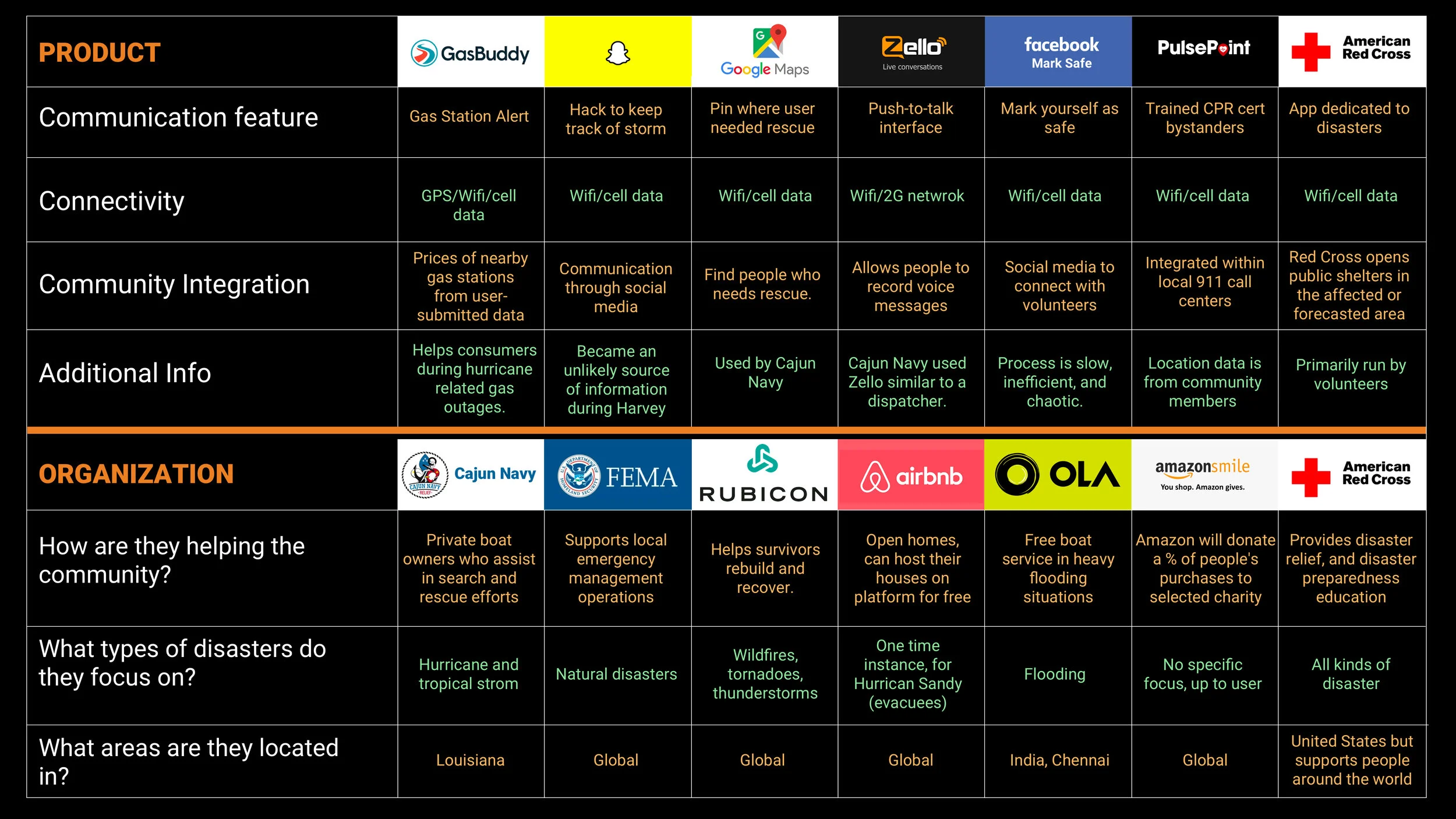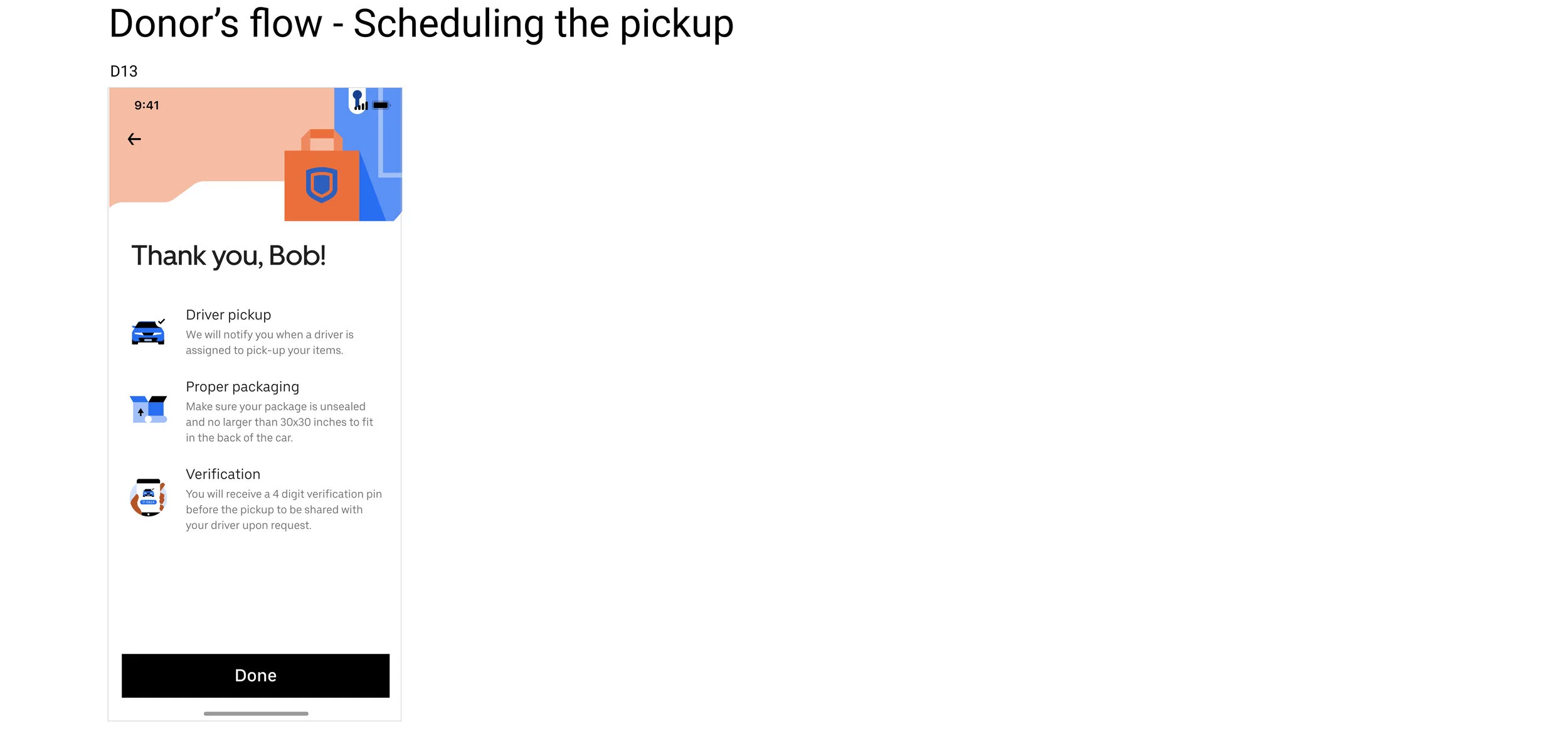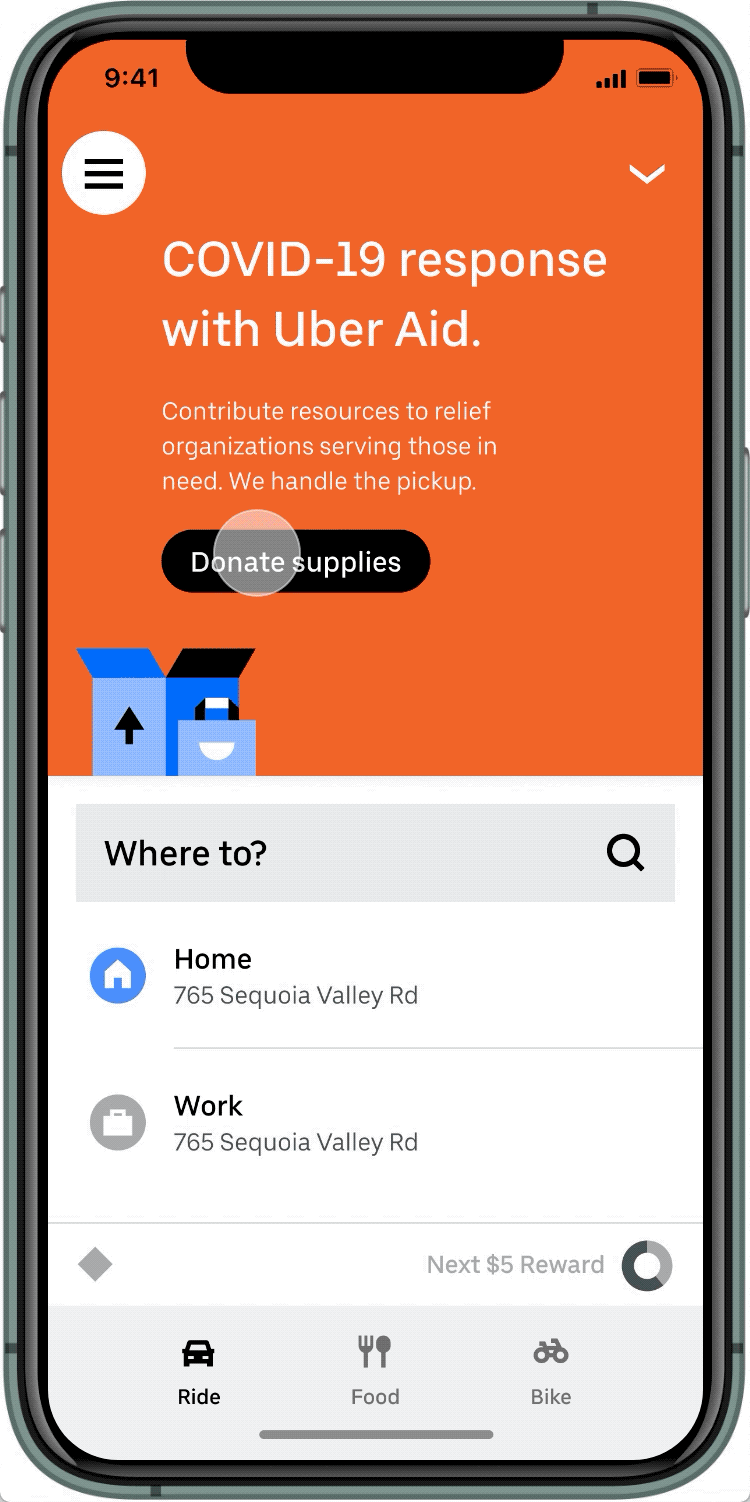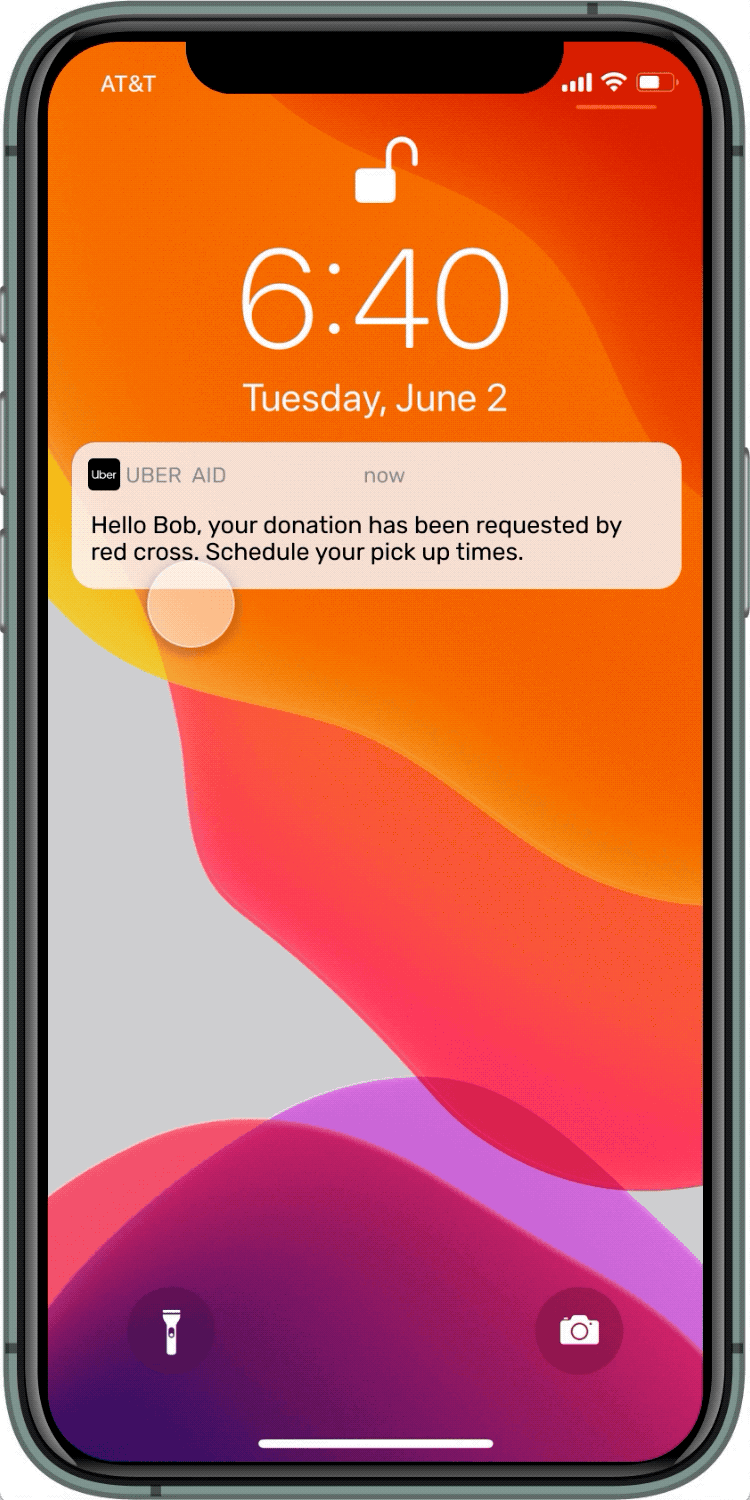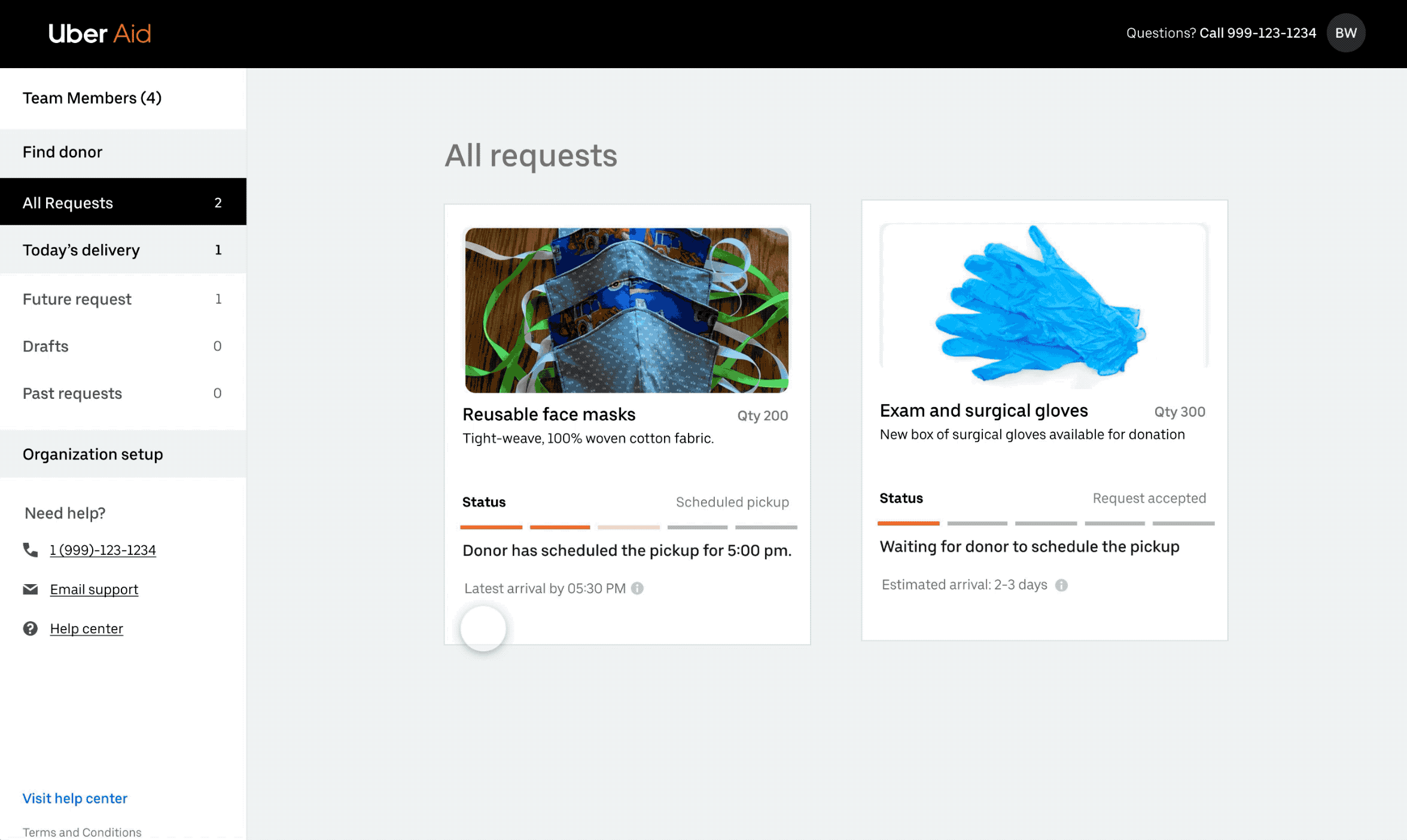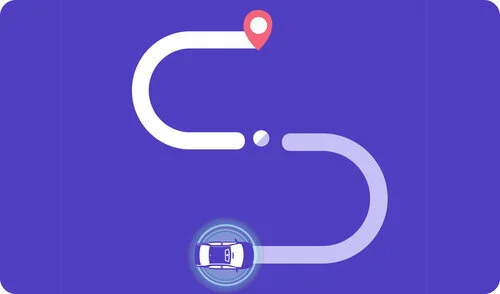Uber Aid
Uber Aid is a platform that connects and encourages the local community to donate essential items to disaster relief organizations.
Target Users
Uber drivers, disaster relief organizations and local communities.
Duration
Jan 2020 - June 2020
My Role
As a UX/UI Designer, I led the application design and iteration phase.
Team
Helen Enguerra - UX Researcher
Jenny Nguyun - UX Researcher
Neha Kaura - UX Designer
Saurya Sinha(me) - UX/UI Designer
Project advisor
Matt Reynolds Principal Product Designer @ Uber
Problem
Underutilized Resources
Uber currently pledges to spend $300K per major disaster but less than 4% of the $300k are utilized during any disaster relief situation.
Opportunity
Leverage Uber’s platform across 900+ cities
Uber has a powerful logistics and coordination platform, such as Uber Freight, Uber Copter, and Uber Eats that can be used to provide aid for people in need during a disaster. It is also in the business of putting people in motion and one of the most complicated aspects of disaster relief is coordination of communication and transportation.
Initial Design Question
How can Uber utilize its existing resources to help local communities during emergency situations?
Final Concept Video
Final Concept




Secondary Research
Research Goals
Understand current partnership
Understand how other companies partner with organizations like Red Cross, NGOs, etc. to provide aid for disaster relief situations.
Rider experience
Learn about the general experience of riders who use ride sharing services.
Driver motivation and support
Learn how to incentivize and motivate drivers to provide support during emergency situations. .
City response
Understand how cities prepare and respond to an emergency.
Design Space
We read the existing literature on disaster relief situations to understand more about what exactly constitutes a disaster and how various agencies come together to support communities during an emergency. The disasters can be categorized into two parts:
01
Immediate disasters: emerge quickly after a particular event such as earthquakes, eruptions, etc.
02
Gradual disasters: emerge gradually over time such as droughts, epidemics etc.
The literature also revealed that there are two main phases of logistics in a disaster management situation.
01
Mitigation and preparedness before a disaster.
02
Response and recovery after a disaster.
Competitive Analysis
I conducted a competitive analysis to understand what solutions are already present, what opportunities are available and how Uber can utilize those opportunities. I combined my research with the research that was done by the internal Uber Aid team, which consisted of designers and researchers at Uber.
The complete analysis can be viewed here, I have added excerpts from it below for a quick view.
Click on the image below see enlarged version
Initial Scoping
Dimensional Analysis
Possible Solutions
This dimensional analysis led to two possible solutions we could pursue for our project.
01
Uber emergency Hubs
Hubs appear on the Uber app in case of an emergency, where users can gather to be picked up by a driver free of cost.
02
Uber Partnership
Transfer of resources to an emergency location, either indirectly via a partner organization such as Red Cross, Cajun Navy or directly via Uber Freight.
Primary Research
Interviews
Since we were designing for high-risk situations, we wanted to perform comprehensive primary research and talk to experts as well as target users in the field. For our interviews we shortlisted:
Subject Matter Expert


Findings
Drivers not willing to drive in high-risk situation
After the analysis, we found that:
Most of the drivers would not drive their car in earthquake or any other disaster location because of the dangers involved.
Riders do not want to interact with strangers during a disaster and want to get home as quickly as possible.
A driver said:
Uber is a secondary source of income, I don't need to drive in an emergency. But maybe I will, if I am having financial issues.
Re-evaluating Possible Solutions
As a result of our findings, we did away with idea of Uber pick-up hubs because of security concerns for both riders and drivers. We iterated the second solution from Partnerships to Partnership Platform because it is a low-risk situation for drivers compared to high-risk situations like pick-up from the gun-shooting area or transferring resources at the disaster location.
With the Partnership Platform, drivers can collect relief resources in the form of donations after a disaster and can drop it off at a designated location selected by the requesting organizations. Drivers would only be responsible for pick-up and drop-off the item from one place to another during a short period after a disaster has happened.
Ideation
Revised Design Question
How might Uber utilize its mobility as a strength for the local community during times of need?
Scenario
We decided to use the COVID-19 pandemic as the emergency situation for our scenario. From our interviews conducted during the pandemic, we learned that drivers are willing to deliver food from restaurants to the users while following extra precautions. Based on this understanding we came up with the following scenario.
User Flow



Design
Initial Mock-ups and Feedback
I started working on wireframes for donor screens in Figma using components from Uber's design library. Our goal was to receive feedback from Uber design team and test our prototypes with users.
For organization flow, I reviewed Uber’s other business platforms like Business Central, Freight and Restaurants. I decided to develop the app on web platform, rather than mobile, as organizations and businesses prefer to works on desktops/laptops instead of a mobile device.
I designed the entire flow for organization and donor use-cases.
Multi Platform Service
Feedback from Uber team
D0: Change donate now to donate supplies
D1: Make changes so donor can donate multiple supplies at a time
D2: Remove sub-category(like reusable face masks, N-95) for now and let the user write the category/type to make it easy for first launch.
D8: Name the steps in progress bar.
Feedback from Uber team
R0: Add organization name and email on the same page to reduce steps
R0: Sign up a team or small organization that would be responsible for receiving the item instead of one person
R7: Do not restrict the number of requests from an organization now, we can learn how receivers are requesting the donation and make changes later.
Final Prototypes
Task 1: Bob donates reusable cloth masks on Uber Aid
Task 2: Red cross registers with Uber Aid
Task 3: Red Cross finds a donor for masks
Task 4: Bob accepts request from Red Cross
Task 5: Uber driver delivers masks from Bob’s place to Red Cross
Task 6: Red Cross tracks the delivery and rates their experience
Outcome
We got an opportunity to present our proof of concept to the stakeholders at Uber. Our solution would help the internal Uber Aid team to further work on the implementation of the platform.
Next Steps
We came up with a lot of ideas during our brainstorming session, we decided to add some of these features in the next iteration after we have gathered feedback from donors, organizations and drivers. Some of the most notable features were:
Providing feedback to donors: The end goal of this idea is to educate and motivate donors for future donations. In our scenario, where Bob donated 500 masks, once the masks are allocated to a hospital or nursing unit, we would like to inform Bob about the same. This increases overall community engagement and serves to spread hope in disastrous times. The feedback does not have to be only positive. For instance, if the quality of the masks rendered them useless, we should inform Bob of same with proper guidelines to ensure that the next batch of donations adhere to them.
Donation requests from organizations: Another use-case that we wanted to accommodate was to have organizations request for needed items, their quantities with a need by date. Similar to how organizations can find donations, donors can also see the donation request and choose to fulfill them based on their capacity and interests.
Reflections
Deep Dive: Disaster management requires a multi faceted approach. Before I came up with a solution, I felt it was important to learn about categories of disaster, current standards of disaster management, explore how non-profit organizations provide aid and communicate with subject matter experts to understand the problem in more detail. I utilized my learning to build and validate the end solution.
Disambiguation: The problem given to us was open-ended. So, in order to come up with an impactful solution, I communicated with my team, my mentors at Uber and used my own learning from the research on the subject. In the end, I not only came up with a working solution but most importantly a plan to deliver it in multiple phases.
Communication: Timely communication with the mentor and team from Uber proved very helpful. I was able to leverage their practical knowledge of the UX domain which helped us catch potential pitfalls early.
Adaptability: The switch to online work because of COVID-19 revealed how adaptable and resilient our team was in completing our project. We experimented with multiple virtual tools in order to figure out what worked for the group. In the end, we extensively used Miro (a collaboration tool) and Zoom for all our meetings since we could no longer meet in-person.





